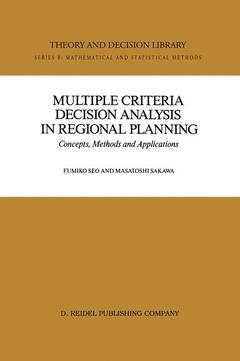Multiple Criteria Decision Analysis in Regional Planning, 1988 Concepts, Methods and Applications Theory and Decision Library B Series, Vol. 10
Langue : Anglais
Auteurs : Seo Fumiko, Sakawa Masatoshi

This book is devoted to presenting theoretical fundamentals for the methods of multiple criteria decision making (MCDM) in the social sciences with particular intent to their applicability to real-world decision making. The main characteristics of the complex problems facing humans in the world today are multidimensional and have multiple objecti ves; they are large-scale, and have nonconimensura te and conflicting objectives, such as economic, environmental, societal, technical, and aesthetic ones. The authors intend to establish basic concepts for treating these complex problems and to present methodological discussions for MCDM with some applications to administrative, or regional, planning. MCDM is composed of two phases: analytical and judgmental. In this book, we intend to consolidate these two phases and to present integrated methodologies for manipulating them with particular interest in managerial decision making, which has not yet been properly treated in spite of its urgent necessi ty. Al though a number of books in MCDM fields have already been published in recent years, most of them have mainly trea ted one aspect of MCDM. Our work specifically intends to trea t the methodology in unified systems and to construct a conceptual structure with special regards to the intrinsic properties of MCDM and its "economic meanings" from the social scientific point of view.
1 Introduction to Multiple Criteria Decision Making.- 1.1 Modern Society as a Problems Complex.- 1.2 General Characteristics of Modern Systems Analysis.- 1.3 Characteristics of Multiple Criteria Decision Analysis.- 1.4 Outline of the Book.- 2 Approach to Multiple Criteria Optimization.- 2.1 Pareto Optimality.- 2.2 Derivation of the Pareto Optimal Frontier.- 2.3 Selection of the Preferred Decisions.- 3 Interactive Multiobjective Mathematical Programming.- 3.1 Goal Programming and Compromise Programming.- 3.2 Interactive Frank-Wolfe Method and Its Variants.- 3.3 Sequential Proxy Optimization Technique (SPOT).- 3.4 Reference Point Method and Its Extensions.- 4 Interactive Fuzzy Multiobjective Programming.- 4.1 Introduction.- 4.2 Interactive Fuzzy Multiobjective Programming without Trade-offs.- 4.3 Interactive Fuzzy Multiobjective Programming with Trade-offs.- 4.4 Interactive Computer Program.- 5 The Preference Structure of Decision Making.- 5.1 Hypothesis of Rational Human Behavior.- 5.2 Expected Utility Hypothesis.- 5.3 The Generalized Nonlinear Utility Function and Risk Attitudes.- 5.4 Application to Technology Assessment for Substitute Energy.- 6 Multiattribute Utility Analysis.- 6.1 Representation Theorem of Multiattribute Utility Functions.- 6.2 Identification of the Single Attribute Utility Function.- 6.3 Identification of the Multiattribute Utility Function.- 6.4 Hierarchical Structuring of Preferences: Nesting.- 6.5 Interactive Computer Program for Subjective Systems.- 7 Value Conflicts in Multiple Agents Decision Making.- 7.1 Extension of Multiattribute Utility Analysis.- 7.2 Approaches to Collective Choice.- 7.3 Probability Assessment and Entropy Model.- 7.4 Fuzzy Multiattribute Utility Analysis.- 7.5 Stochastic Dominance Rules for Collective Choice.- 8 Reconsideration of Preference Structure.- 8.1 Strength of Preference and Measurable Value Functions.- 8.2 The Measurable Value Function for Risky Choice.- 8.3 Partial Comparable Axioms without Transitivity.- 9 Resource Allocation and Duality.- 9.1 Introduction.- 9.2 Economic Analysis and Equilibrium Prices.- 9.3 Shadow Market and Imputed Prices.- 10 Imputation of Dual Prices.- 10.1 Introduction.- 10.2 Nonlinear Programming and Dual Prices.- 10.3 The Kuhn-Tucker MUltiplier as General Evaluation Factor.- 10.4 Nested Lagrangian Multiplier (NLM) Method.- 11 Applications of the Nested Lagrangian Multiplier (NLM) Method.- 11.1 The Nested Lagrangian Multiplier (NLM) Method in Application.- 11.2 MUltiobjective Evaluation of Regional Planning in the Greater Osaka Area: A Static Case.- 11.3 MUltiobjective Evaluation of Regional Planning in the Grea ter Osaka Area: A Dynamic Case.- 11.4 Industrial Land-use Program Combined with Water Quality Control: A Dynamic Case.- 12 Interpretation of Duality in Game Theory.- 12.1 Introduction.- 12.2 Noncooperative Games (Two-person Zerosum).- 12.3 N-Person Cooperative Games and Nucleolus.- 12.4 Example: Evaluation for Efficient Formation of Interregional Agreement.- 13 Propriety of Multiple Criteria Decision Making for Human Affairs: Social Implementation and Personal Behavior.- 13.1 Introduction.- 13.2 Properties and Functions of the Decision Maker.- 13.3 Hierarchical Structure of Human Needs.- 13.4 Cultural Domain in Decision Making.- 13.5 Concluding Remarks.- References.- Bibliography on Multiple Criteria Decision Making (Books).- (Collective Papers).
Date de parution : 10-2011
Ouvrage de 536 p.
15.2x22.9 cm
Mots-clés :
calculus; game theory; linear optimization; nonlinear optimization; optimization
© 2024 LAVOISIER S.A.S.



